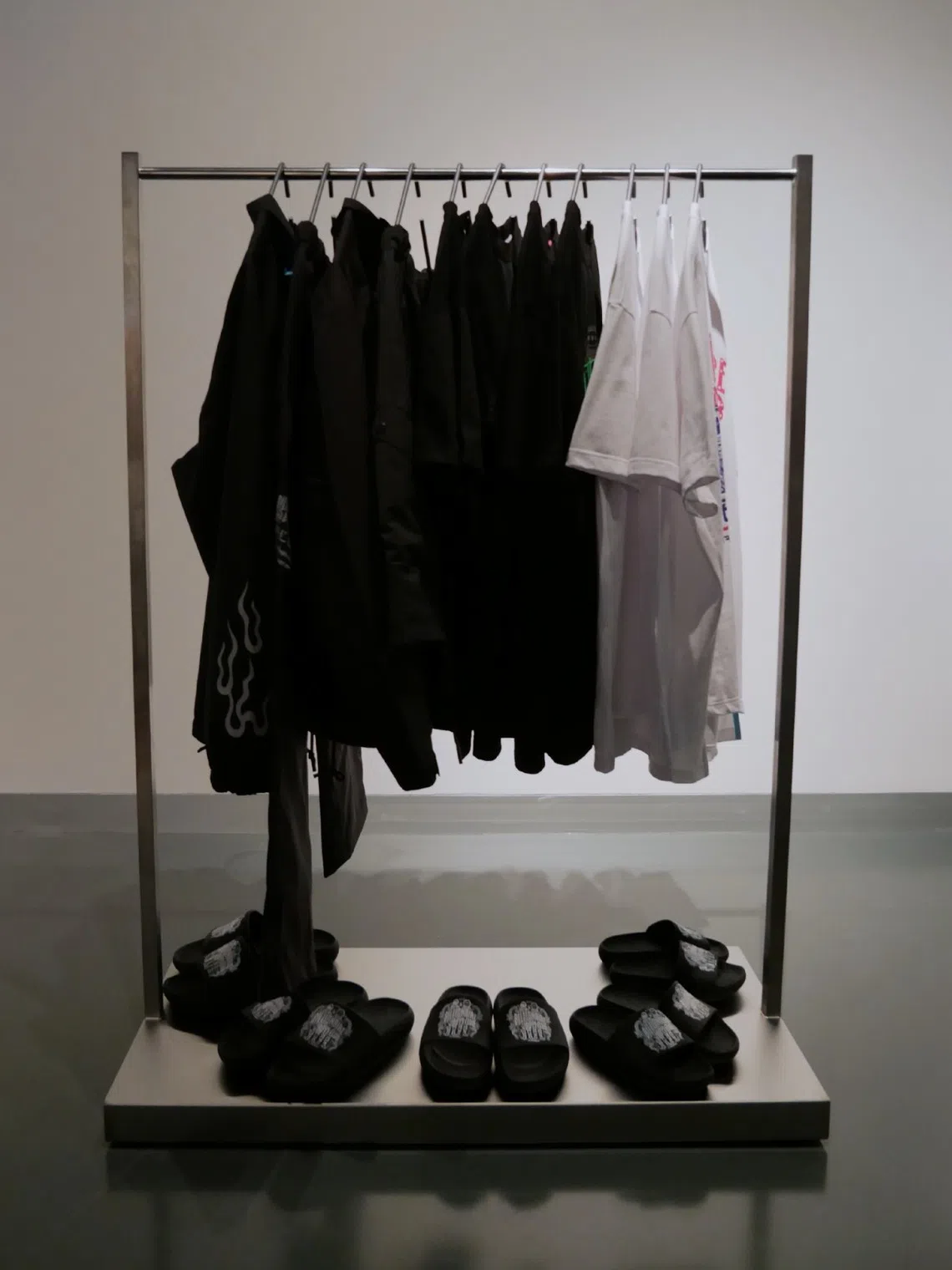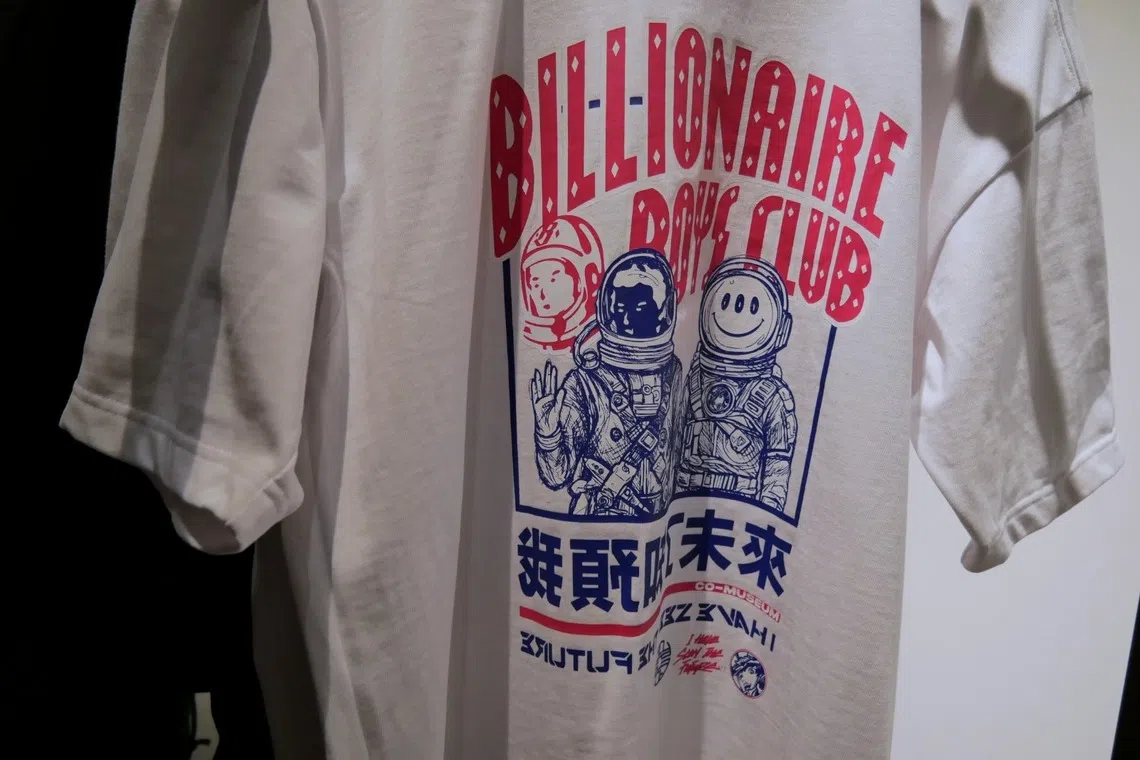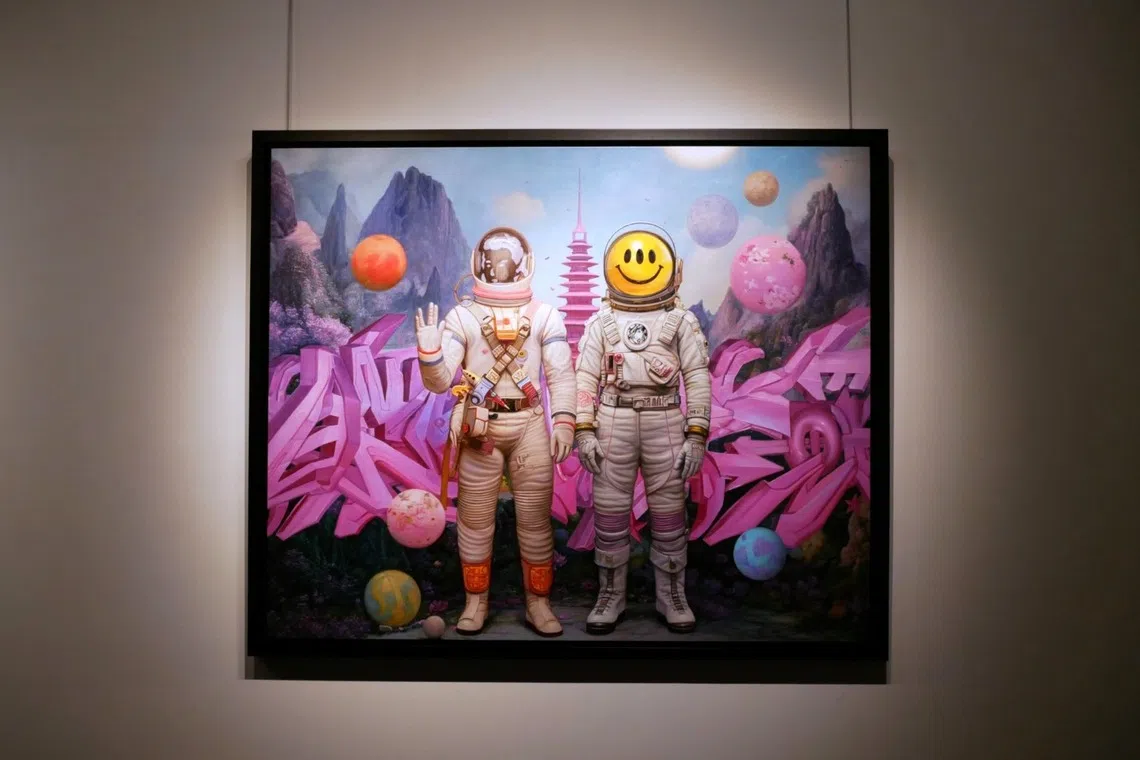Singapore pop artist Jahan Loh makes art and apparel for Pharrell Williams’ Billionaire Boys Club
Sign up now: Get ST's newsletters delivered to your inbox

Artist Jahan Loh (centre), founder of ArtCEO Jonathan Toh (left) and co-founder of ACU Michael Chung (right) with Loh's sculptures at Le Freeport.
PHOTO: THE RIGHT SPIN
Follow topic:
- Singaporean artist Jahan Loh collaborates with Billionaire Boys Club for apparel, blending Eastern and Western styles with spacemen themes.
- An exclusive exhibition at Le Freeport Singapore showcases Loh's art evolving into 3D-printed clothing, and also features a pair of polystone astronaut sculptures.
- Loh envisions making art accessible through collaborations, shared ownership and merchandise.
AI generated
SINGAPORE – Singapore pop artist Jahan Loh has been commissioned by Billionaire Boys Club to translate his iconic spacemen into apparel blending East and West, in an international project.
The New York fashion label was co-founded by American singer-designer Pharrell Williams and Japanese fashion designer and DJ Nigo in 2003, regularly initiating cross-cultural collaborations for its luxury streetwear sweatshirts and sneakers.
For the next two weeks, a small “capsule” exhibition tracing the evolution of Loh’s work – paintings of spacemen which developed into sculptures and then finally 3D-printed slippers, waterproof coat jackets and T-shirts – will be on show at Le Freeport Singapore.
The exclusive high-security storage and boutique showroom facility in Changi North – where expensive art and precious metals are held and traded tax free – means entry to the exhibition is by-invite-only for an “if you know, you know” preview.
Loh’s spacemen motif is a continuation of his vision of spaceships becoming as commonplace as planes in the next half-century, and is one which he also iterated in an eye-catching 3m-by-3m AI video at Marina Bay Sands mega fair Art SG in January.
The reserved Loh, 48, who has always straddled art and design, says: “We may one day casually call out ‘Meet you in Mars for lunch.’”
The futurist’s sources of inspiration are classic: the Star Wars franchise (1977 to present) and Stanley Kubrick’s film 2001: A Space Odyssey (1968). He has avoided explicitly Oriental touches in his art, but lets slip a hint of Asian pride in his fixation. “Sci-fi came from the West, but the Chinese may be the first to go to Mars.”
The garments created for Loh’s art-to-fashion project are almost all in black, incorporating Chinese elements like frog buttons and Mandarin collars, while using waterproof material similar to Gore-Tex to give these “heritage” looks a modern ruggedness.
T-shirts weigh 300g, “over twice that of standard Uniqlo T-shirts”, says Mr Michael Chung, the Hong Kong-born co-founder of ACU. The Shanghai-based lifestyle brand was also roped in to work with Loh on the apparel.
The clothes will soon be stocked in to-be-announced stores, starting at US$75 (S$96.50) for T-shirts and going up to US$250 for a reversible coat jacket.
The entire project was facilitated by art business ArtCEO’s Singaporean founder Jonathan Toh, who says of the underlying ethos: “The idea is if a person were to go to space, he would dress up.”

The apparel includes 3D-printed slippers, T-shirts, pants and coat jackets.
PHOTO: THE RIGHT SPIN
At the centre of the exhibition – and the creative process – are two 2m-tall astronaut sculptures, cast from polystone and painstakingly painted black by Loh.

T-shirts featuring Loh’s works go for US$75.
PHOTO: THE RIGHT SPIN
Titled I Have Seen The Future, the sculptures have helmets fitted with LED screens and stand on a base inspired by ancient Chinese star charts.
These are for sale, too, to a more exclusive coterie. The idea is for eight individuals or brands to each fork out $12,000 to co-own the sculptures. Each collector will receive a smaller pair standing at 69cm and a digital certificate of ownership.
Also on show are the two more colourful paintings which the sculptures are based on. One of them, Genesis: Billionaire Boys Club, contains a rendering of Loh’s Chinese name in his signature style synthesising calligraphy and graffiti, collapsing past and future, Asian and Western.

Jahan Loh’s work Genesis: Billionaire Boys Club, which inspired the collection.
PHOTO: THE RIGHT SPIN
Mr Toh describes himself as the “conductor” of the various creative elements in this multimedia showcase. The collaboration also includes Singapore’s Co-Museum, which focuses on non-fungible token (NFT) art and has expertise in fractional ownership, or shared ownership of artworks.
Mr Toh wants to curate the eight co-owners of Loh’s sculptures so that they, together, stand for something more. He gives as an example a collective of international brands interested in blurring the boundaries between art, design, fashion and merchandise. The co-owners should ideally not all be from Singapore.
More creatives have refused to accept art’s traditional silos since the Covid-19 pandemic, he says. “Rather than ask how to attract people into the gallery, we ask how to take art out of this intimidating space. We are opening up new ways of collecting and more mediums to say the same message.”
In January, he worked with Loh and American street artist Stash for a spacemen exhibition at Bangkok’s Central Chidlom department store that was also complemented with bespoke baseball caps and tote bags.
Loh’s work in different forms means his art is now also available to the iconoclastic young. “The new generation has different buying patterns. They won’t spend $5,000 on a painting, but they can watch a $500 concert 10 times. (K-pop stars) G-Dragon and Rose are all doing immersive art programmes. The borders are collapsing.”
Organisers say the exhibition may travel to Shanghai, Dubai or other major cities in the coming months to reach audiences farther abroad.


